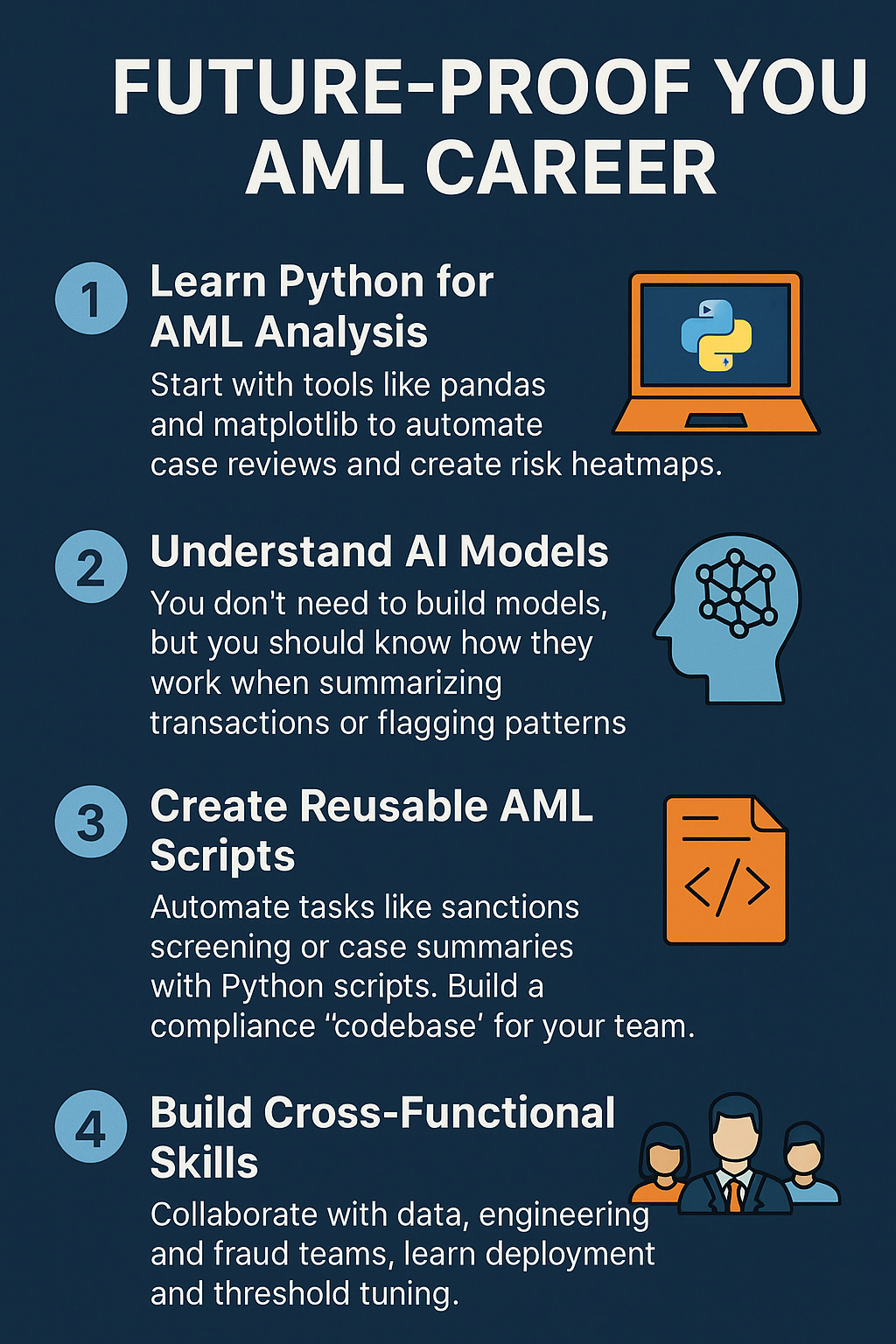Issue #18 – How to Build a Career-Proof AML Skillset with AI & Python
Polar Insider | Issue #18 | Week of 02 July 2025
🧊 Introduction
Hi there,
Welcome to this week’s edition of Polar Insider. This issue explores a powerful shift in the compliance world: how artificial intelligence and Python programming are becoming essential tools for AML professionals who want to stay relevant and irreplaceable.
Here’s what you’ll find inside this issue:
📌 Top Story – How to Build a Career-Proof AML Skillset with AI & Python
🔎 Case Study – How One Analyst can use Python to Expose Suspicious Shell Activity
🌍 Regulatory Roundup – Key updates from North America, Europe, and Asia-Pacific
🛠️ Compliance Toolkit – Python libraries, AI courses, and AML data resources
📌 Top Story
How to Build a Career-Proof AML Skillset with AI & Python
🎥 Prefer to watch? Catch the 48-sec explainer:
The compliance world is evolving fast. AI tools are transforming how we detect suspicious activity, and regulators are raising the bar for technical expertise. If you’re still relying on Excel or vendor platforms alone, you might be automating yourself out of a job.
What’s Happening
Financial institutions and fintechs are ramping up their use of AI for transaction monitoring, customer screening, and fraud detection. At the same time, demand for compliance analysts with Python and data analysis skills is skyrocketing.
Entry-level roles now expect candidates to:
Manipulate data frames
Use APIs
Fine-tune AI prompts
AI tools like GPT-4, LangChain, and AutoML are already reshaping how we interpret typologies, generate risk summaries, and analyze unstructured data. But human oversight remains critical—and that oversight increasingly requires technical fluency.
The Risk to Compliance Teams
Static roles and manual processes are being replaced by automation. Without technical skills, analysts risk redundancy when budgets tighten.
What You Can Do

🧠 Pro Tip: Start small. Pick a real-world AML problem—like transaction reviews—and build a basic Python script to solve it. Then scale up.
🔎 Case Study
🐍 How One Analyst can use Python to Expose Suspicious Shell Activity
Legacy AML systems often miss subtle patterns, especially when illicit actors use fragmentation to stay below detection thresholds.
Here’s how a Python-powered approach can help spot what rules-based engines don’t:
💡 Imagine an analyst pulling 90 days of wire data and using Python (pandas, matplotlib) to group transactions by beneficiary. By filtering for companies receiving 5+ payments per month, sharing device/IP identifiers, and having overlapping surnames among beneficial owners, suspicious clustering begins to emerge.
With just a few lines of code, the analyst uncovers circular flows between entities, ultimately pointing to a central node overseas, indicative of a trade-based money laundering (TBML) network.
This kind of insight is nearly impossible to gain through manual review or static threshold rules. But with Python, it becomes not only feasible, but repeatable.
Key Lessons for AML Teams
🚨 Don’t rely solely on vendor alerts. Custom scripts can uncover what systems miss.
🔐 Python Drives Efficiency: Python enables pattern detection through grouping, pivoting, and simple visualizations.
🧱 Empower your team with Python skills to automate repetitive reviews and uncover complex risks faster.
The FinCEN Files highlighted how technical skills like Python are critical for uncovering hidden risks and driving meaningful regulatory change in the fight against financial crime.
🌍 Regulatory Roundup
🇺🇸 North America
FinCEN launches a pilot program for AI-assisted SAR reviews in mid-size banks.
SEC warns against over-reliance on black-box AI tools.
FINTRAC (Canada) updates AML training guidelines to include data competency.
🇪🇺 Europe
EU AMLA consultation paper emphasizes technical upskilling for supervisors.
UK FCA expects AML officers to demonstrate “data fluency” in upcoming assessments.
Netherlands pilots a shared sanctions database powered by AI.
🇦🇺 🇸🇬 🇭🇰 Asia-Pacific
AUSTRAC (Australia) calls for bridging the gap between AML officers and tech teams.
Singapore MAS trials AI-driven KYC with three banks.
HKMA (Hong Kong) releases a paper on “Human + AI collaboration” in AML.
Key Message: Regulators are pushing for not just the use of technology, but also a deeper understanding of it by compliance professionals.
🛠️ Compliance Toolkit
Equip yourself with these resources to stay ahead:
• “Python for AML Professionals” – Free GitHub Repo
📎 Link → github.com/aml-python
• IBM Data Analyst Certificate (Coursera)
📎 Link → coursera.org/ibm-data-analyst
• Prompt Engineering Specialization (Coursera)
📎 Link → coursera.org/specializations/prompt-engineering
• FATF Report: Opportunities and Challenges of new Technologoes AML/CFT
📎 PDF → fatf-gafi.org
💬 Quote of the Week
“AI won’t replace compliance professionals—but those who use AI will replace those who don’t.”
– Andrew Moyle, Partner, Technology & FinCrime, UK
🎁 Bonus for Subscribers
Don’t forget to download your copy of the 2025 Financial Crime Regulatory Tracker (USA, UK, AU).
Stay on top of AML requirements and enforcement trends globally.
👉

